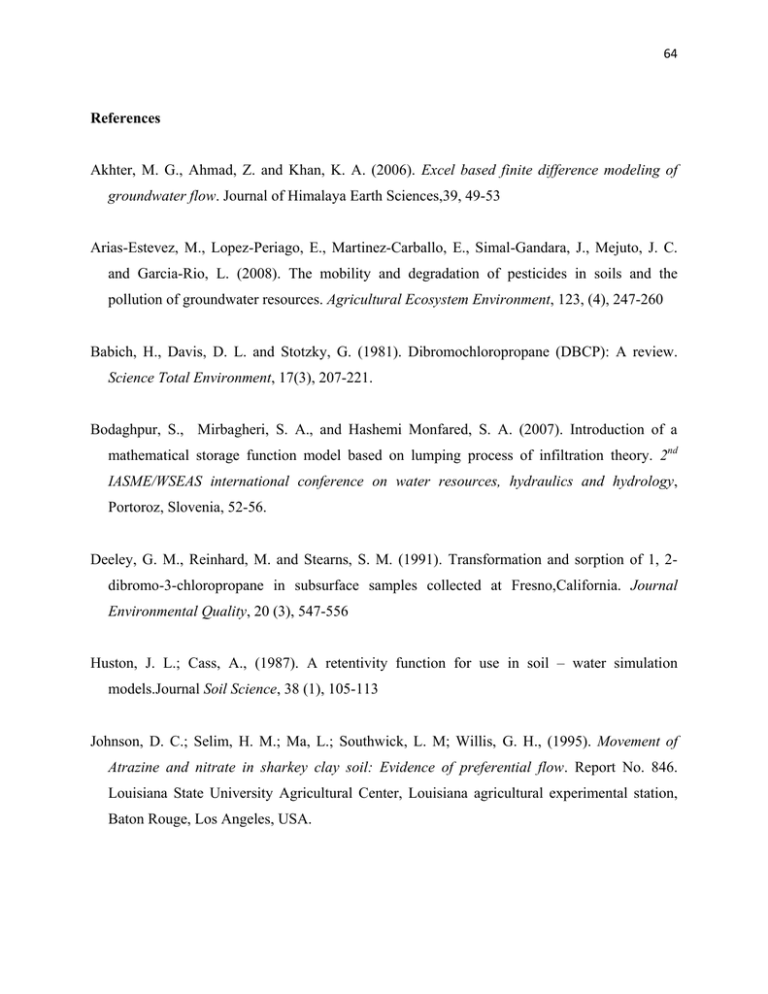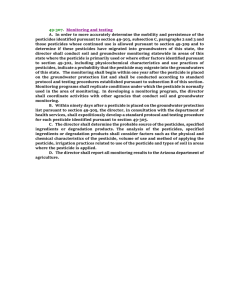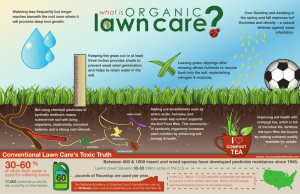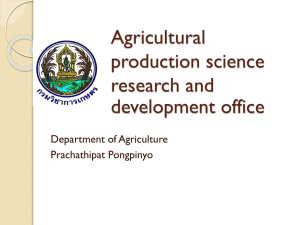References Excel based finite difference modeling ... Arias-Estevez, M., Lopez-Periago, E., Martinez-Carballo, ...
advertisement

64 References Akhter, M. G., Ahmad, Z. and Khan, K. A. (2006). Excel based finite difference modeling of groundwater flow. Journal of Himalaya Earth Sciences,39, 49-53 Arias-Estevez, M., Lopez-Periago, E., Martinez-Carballo, E., Simal-Gandara, J., Mejuto, J. C. and Garcia-Rio, L. (2008). The mobility and degradation of pesticides in soils and the pollution of groundwater resources. Agricultural Ecosystem Environment, 123, (4), 247-260 Babich, H., Davis, D. L. and Stotzky, G. (1981). Dibromochloropropane (DBCP): A review. Science Total Environment, 17(3), 207-221. Bodaghpur, S., Mirbagheri, S. A., and Hashemi Monfared, S. A. (2007). Introduction of a mathematical storage function model based on lumping process of infiltration theory. 2nd IASME/WSEAS international conference on water resources, hydraulics and hydrology, Portoroz, Slovenia, 52-56. Deeley, G. M., Reinhard, M. and Stearns, S. M. (1991). Transformation and sorption of 1, 2dibromo-3-chloropropane in subsurface samples collected at Fresno,California. Journal Environmental Quality, 20 (3), 547-556 Huston, J. L.; Cass, A., (1987). A retentivity function for use in soil – water simulation models.Journal Soil Science, 38 (1), 105-113 Johnson, D. C.; Selim, H. M.; Ma, L.; Southwick, L. M; Willis, G. H., (1995). Movement of Atrazine and nitrate in sharkey clay soil: Evidence of preferential flow. Report No. 846. Louisiana State University Agricultural Center, Louisiana agricultural experimental station, Baton Rouge, Los Angeles, USA. 65 Jury, W. A.; Spencer, W. F.; Farmer, W. J., (1983). Behavior assessment model for trace organics in soil: I. model description. Journal Environmental Quality, 12 (4), 558-564 Kah, M.; Brown, C. D., (2007). Changes in pesticide adsorption with time at high soil to solution ratios. Chemosphere, 68 (7), 1335–1343 Kalita, P. K.; Ward, A. D.; Kanwar, R. S.; McCoo, D. K., (1998). Simulation of pesticide concentrations in groundwater using Agricultural Drainage and Pesticide Transport (ADAPT) model. Agricultural Water Management, 36 (1), 23–44 Kloos, H., (1983). DBCP pesticide in drinking water wells in Fresno and other communities in the central valley of California. Ecol. Dis., 2 (4), 353-367 Loague, K.; Bernknopf, R. L.; Green, R. E.; Giambelluca, T. W., (1996). Uncertainty of groundwater vulnerability assessments for agricultural regions in Hawaii: Review. Journal Environmental Quality, 25 (3), 475-490 Loague, K.; Lloyd, D.; Nguyen, A.; Davis, S. N.; Abrams, R. H., (1998). A case study simulation of DBCP groundwater contamination in Fresno County, California 1. Leaching through the unsaturated subsurface. Journal Contamination Hydrology, 29 (2), 109-136 Lim, C. Y. (2014, March 3). In search of water. The Star Online. Retrieved April 4, 2014, from http://www.thestar.com.my Mair, A. and El-Kadi, A. I. (2013). Logistic regression modeling to asses groundwater vulnerability to contamination in Hawaii, USA. Journal of Contaminant Hydrology, 153, 123. Magri, A. (2007). Fate and transport modeling of pesticides applied to turf. Doctor Philosophy, Cornell University 66 McCreanor, P.T., and Reinhart, D. R. (2000). Mathematical modeling of leachate routing in a leachate recirculating landfill. Water resources, 34 (4), 1285-1295. Mirbagheri, S. A. (2004). Modeling contaminant transport in soil column and groundwater pollution control. International Journal of Environmental Science and Technology. 1(2), 141150. Mirbagheri, S. A. and Hashemi Monfared, S. A. (2009). Pesticide transport and transformation modeling in soil column and groundwater contamination prediction. International Journal Environmental Science Technology, 6(2), 233-242 Mirbagheri, S. A., and Kazemi Esfeh, H. R. (2008). Finite element modeling of leaching from a municipal landfill. Journal of Applied Sciences. 8 (4), 629-635. Mirbagheri, S. A., Tanji, K. K., and Rajaee, T. (2006). Selenium transport and transformation modeling in soil columns and groundwater contamination prediction. Proceedings of the 7th International Conference on HydroScience and Engineering. 10-13 September. Philadelphia, USA. 2475-2483 Muhamad, I. C. and Abd. Karim, M. H. (n. d). Groundwater availability and quality in Malaysia. Unpublished note, Mineral and Geoscience Department Malaysia. Muller, T. S.; Sun, Z.; Kumar, M. P. G.; Itoh, K.; Murabayshi, M., (1998). The combination of photocatalysis and ozonolysis as a new approach for cleaning 2,4- dichlorophenoxyaceticacid polutted water. Chemosphere, 36 (9), 2043-2055 Oreskes, N.; Shrader-Frechette, K.; Belitz, K., (1994). Verification, validation and confirmation of numerical models in the earth sciences. Science, 263 (5147), 641-646 67 Owabor, C. N. and Ekwonu, C. M. (2009). Use of finite element method as a simulation technique for bioremediation of naphthalene, anthracene and pyrene contaminated soil in a fixed bed reactor. International Journal of Physical Sciences, 4(5), 321-326 Qasim , S. R.; Burchinal, J. C., (1970). Leaching of pollutants from refuse beds. Journal sanitary Engineering division, 96 (1), 49-58 Rovers, F. A.; Farquhar, G. j., (1973). Infiltration and landfill behavior. Journal Environmental Engineering, 99 (5), 671-690 Scholtz, M. T.; Bidleman, T. F., (2007). Modeling of the long term fate of pesticide residues in agricultural soils and their surface exchange with the atmosphere: Part II projected long-term fate of pesticide residues. Science Total Environmental, 377 (1), 61–80 Singh, A. (2014). Groundwater resources management through the applications of simulation modeling: A review. Science of the Total Environment. Smith, A.E. and D.C. Bridges. 1996. Movement of certain herbicides following application to simulated golf course greens and fairways. Crop Science, 36: 1439 – 1445. Stevenson, D. E.; Baumann, p.; Jackman, J. A., (1997). Pesticide properties that affect water quality. Texas agricultural extension service, B-6050. Taube, J.; Vorkamp, K.; Forster, M.; Herrmann, R., (2002). Pesticide residues in biological waste. Chemosphere, 49 (10), 1357-1365 Tiktak, A. (2000). Application of pesticide leaching models to the Vredepeel dataset II Pesticide fate. Agricultural Water Management, 44, 119-134. 68 USDA, (2006), 2,4-D human health and ecological risk assessment, United States Department of Agriculture, Forest Service, Forest Health Protection, Final report, USDA Forest Service Rosslyn Plaza Building C, Room 7129C 1601, North Kent Street Arlington, VA 22209 September 30. Vorkamp, K.; Taube, J.; Herrmann, R., (1997). Multiresidue analysis of pesticides and their metabolites in biological waste. In: Stentiford, E. I. (Ed.). Organic recovery and biological treatment, Zeebra Publishing, Manchester, 221-225 Wagenet, R. J.; Hutson, J. L., (1986). Predicting the fate of nonvolatile pesticides in unsaturated zone. Journal Environmental Quality, 15 (4), 315-322 Wagenet, R. J.; Hutson, J. L., (1987). LEACHM: Leaching Estimation and Chemistry Model: A process based model of water and solute movement transportation, plant uptake and chemical reactions in unsaturated zone, continuum Volume 2, Water Resources Institute, Cornell University, Ithaca, New York ,USA. Wagenet, R. J.; Huston, J. L.; Biggar, J. W., (1989). Simulating the fate of a volatile pesticide in unsaturated soil: A case study with DBCP. Journal Environmental Quality, 18 (1), 78-84 Walsh, J. J.; Kinman, R. N., (1979). Leachate and gas production under controlled moisture conditions, municipal solid waste: Land disposal. Proceedings of the 5th. Annual research symposium, EPA-600/9-79-023a, USEPA, Cincinnati, OH, 41-57 Wei, C., Xingchang, Z. and Ye, F. (2011). Transport of selenium and its modeling through one dimensional saturated soil columns. African Journal of Agricultural Research, 6(8), 20022009 Yates, S. R. (1993). Determining off-site concentrations of volatile pesticides using the Trajectory-Simulation Model. Journal of Environmental Quality, 22, 481-486 69 Zbytniewski, R.; Buszewski, B., (2002). Sorption of pesticides in soil and compost. Pol. Journal Environmental Study, 11 (2), 179-184







